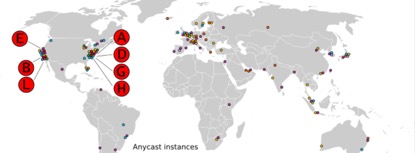100% Pass Cisco, PMP, CISA, CISM, AWS Dumps on SALE!
Get Now
01:59:56
X
Does the DNS root server store all the domain in the world?
If I apply for a domain name for my personal website, have I taken up the resources of the DNS root server? If not, whose resources do I have?
The root domain name server only stores its next-level name servers. The next-level servers mainly include com, net, org, mil, or national domain names such as cn.
The Com server is used to manage domain names with the suffix ".com", such as google.com, cisco.com. Other domain name resolution and so on. When Xiaoming enters the www.goole.com domain name in the browser and hits enter, the browser needs to resolve it to an IP address in order to really communicate. Xiaoming's computer is usually configured with a local name server. In fact, this local name server exists only to speed up domain name resolution. In order to let the reader know more clearly how the domain name resolution works, now assume that the domain name (DNS) server configured by Xiaoming is not a local server, but any one of the 13 root domain name servers, such as 198.41.0.4.

First query (root-level domain name)
Xiaoming will send a DNS query request to the root domain name server 198.41.0.4 (please resolve the IP address of www.goole.com), because the root server (old grandfather) does not have the record, but he knows that one of his children may You know, this kid's name is com server (dad). So this root server (old grandfather) kicked the ball back and told Xiaoming his child (daddy) 's IP address, so that Xiaoming could contact his father directly.
Second query (first-level domain name)
Xiaoming's computer went to contact the com server (dad) again and requested to resolve the IP address of www.goole.com. Dad manages the (authoritative) database himself and only queries the IP address corresponding to google.com, but does not have the IP address corresponding to www.google.com. But Dad thought his son (goolge.com) might know that he would return the IP address corresponding to google.com to Xiaoming's computer.
Third query (second-level domain name)
Xiaoming's computer persisted, and continued to look up the IP address of the son in front (please resolve the IP address of www.goole.com). The son smiled when he saw the domain name. Isn't this the name of his child www.google.com (grandson), he retrieved his IP address (216.58.200.36) in the database and returned it to Xiaoming Computer. It means that Xiaoming's computer only parses the domain name, and it runs three round trips, which requires three RTT delays. It also takes 1.5 RTT time delays to establish a TCP connection, and then at least 2 RTTs to establish a TLS secure connection. It also requires at least 1 RTT time delay for HTTP business transactions. It takes at least 7.5 RTT times, with an average RTT = 200ms, which means that Xiao Ming needs 1.5 seconds to see the http page at the fastest.
Here comes the question. Is Internet domain name resolution really deployed this way?
Obviously this is not the case, but a local name server is commonly used. The local name server will provide domain name resolution services for users such as Xiao Ming.
Local name server cache service
The DNS server configured on Xiaoming's computer is a local server, assuming 114.114.114.114.
Xiaoming directly contacts the server for query service. The server queries its own cache, and finds that Xiaoli has just checked the IP address of www.google.com, and it is hot in the cache, so she returns it.
The rest of the work is similar to the above, this communication process only takes 1 + 1.5 +2 +1 = 5.5 RTT time delay.
You may notice a keyword: Non-authoritative Response. What does this mean? The corresponding vocabulary is the authoritative response, which has been explained above.
Non-authoritative response
The local domain name server caches the information queried by other users for responding to Xiao Ming. This response is a non-authoritative response. The information that Xiaoming queried three times from the root level query, the first level query, and the second level query was directly obtained from the google.com domain name server.
Usually non-authoritative responses, in order to maintain maximum synchronization with authoritative name servers, query entries need to be refreshed periodically, otherwise they will be deleted after aging.
The above is the news sharing from the PASSHOT. I hope it can be inspired you. If you think today' s content is not too bad, you are welcome to share it with other friends. There are more latest Linux dumps, CCNA 200-301 dumps and CCNP Written dumps waiting for you.
Cisco Dumps Popular Search:
300 de 410 ccna 2 chapter 7 pdf ccna 200-301 boot camp cisco dumps site cisco ccna routing cisco certification architect cisco certification badges ccnp route netacad final exam ccie lab hours ccie security lab 7
Copyright © 2025 PASSHOT All rights reserved.






